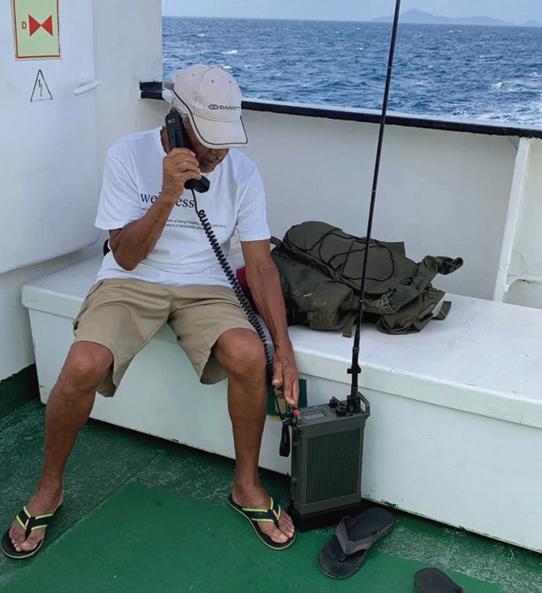
3 minute read
Emergency communications where they are needed most: Bringing HF radio to the Caribbean
In 2004, over 250,000 people lost their lives in a tsunami caused by a massive earthquake in Indonesia. Communications handsets donated by international organisations played a role in the relief effort. This gave RRL director Donald De Riggs an idea: what if the Caribbean islands had access to emergency communications infrastructure before disaster struck? “We are in the process of developing a domestic HF network. If we could get some radios to assist us, we’d be in a much better position to respond to emergencies. When disaster strikes, the critical period is the first 36 to 48 hours,” explains De Riggs. “Having a functional emergency communications network during that period is vital. “
De Riggs’ response to the Indonesia disaster, published in Radio Response International, caught the attention of Cameron Berg from Barrett Communications. Fast-forward to today, and Barrett has supplied three shipments of donated radio equipment to RRL, the latest shipment arriving in February 2023.
The Rainbow Radio League and Barrett Communications are bringing vital emergency communications infrastructure to the Caribbean. Here’s how an ambitious relationship was born with the vision to save lives.

In St Vincent and the Grenadines, and the surrounding islands, emergency communications equipment is transforming disaster response. Located in the Caribbean’s hurricane belt and in proximity to an active volcano, La Soufrière, the islands are prone to natural disasters. With donated equipment from radio experts Barrett Communications, the Rainbow Radio League (RRL) is establishing communications networks and providing training that is geared to saving lives.
Disaster and opportunity
RRL is a not-for-profit organisation of primarily radio amateurs. Since 1995, RRL has focused on providing emergency communications in St Vincent and the Grenadines and the surrounding nations.
High frequency (HF) and very high frequency (VHF) radio offers invaluable functionality, explains De Riggs: “With handsets, like a walkie-talkie, operation is limited because if you don’t have many repeaters, you are limited to a particular geographic area. HF radio has a much wider scope.”
In the Caribbean, where VHF signals can be blocked by mountainous terrain and many of the islands are remote, HF radio offers unprecedented connectivity.
Strength in partnership
“Barrett has a vision, and they understand what our mission is,” says De Riggs. “They realised that we needed the tools, and they provided most of these tools.” RRL has received equipment including HF radios, solar panels and small computers. The latest shipment also included broad band dipole antennae, portable antenna masts and spare microphones. Most of it is exdemonstration equipment, meaning it arrives in virtually mint condition.
The equipment has enabled RRL to set up communication stations in the most critical and vulnerable areas in St Vincent and the Grenadines, and to respond to domestic and regional disasters. In 2017, Hurricane Maria caused devastation to the neighbouring island of Dominica. RRL sent a joint medical and emergency communication team as part of the relief effort.
“We used Barrett equipment to go out in the field and do damage assessment. I could relay information to different agencies in St Vincent, Antigua and Barbados,” says De Riggs. “We were able to coordinate the arrival of over 30 doctors who came to do a rapid assessment of the medical situation.”
After RRL’s rotation, the team left behind solar panels provided by Barrett to enable the local FM station to broadcast to nearby communities essential information about relief supplies including food, water and shelter, enabling the operation to continue after they had left.
Amateur radio operators in St. Vincent and the Grenadines were in daily contact with regional disaster response agency CDEMA before and during the recent eruption of La Soufrière in St Vincent.

St Vincent is now home to nearly 10 stations, including a station overlooking the airport in Bequia. Now, as the 2023 hurricane season approaches, RRL will be conducting training exercises. “We keep radio operators active and give them hands-on experience,” says De Riggs.
“We also work very closely with our National Emergency Management Organisation (NEMO) and train their staff,” adds De Riggs. “We have a symbiotic relationship with them. We also train the port authority and policemen who work in Telecoms.” RRL also works alongside local fishermen, the coastguard and the local Red Cross to run open water rescue simulations.
And the radio amateurs of the future are being fostered through RRL’s engagement with schools. RRL provides demonstrations and involves students in erecting rapid deployment antenna and wireless linkup. This engagement provides children opportunities to pursue careers including air traffic control and the police. RRL eventually aims to involve all the secondary schools on the island.
A bright future
“I have been blown away by the kindness from Barrett, and the relationship is excellent,” says De Riggs. “Anytime we have any problems with the equipment, the technicians will help, and if there needs to be a replacement, they send it.
“In this last shipment, we were able to get some antennae that were very strong, very sturdy. The latest equipment is the new Barrett 4050 HF SDR Transceiver, and the operators who are using them are very impressed with the features.”

And RRL continues to work on expanding its response capabilities, with ambitions to establish proper maritime rescue capabilities and air response for regional disasters. “As an organisation, we haven’t realised our full potential yet,” says De Riggs. “But with adequate funding and agencies that understand and support our role in disaster management, that potential will be realised.”
For further information on the Barrett Communications range of solutions, visit: www.barrettcomms.com










